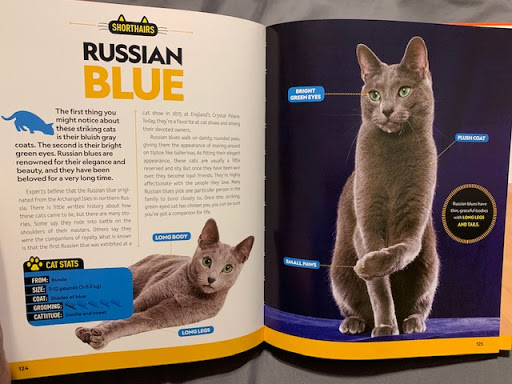1. Donskoy cat
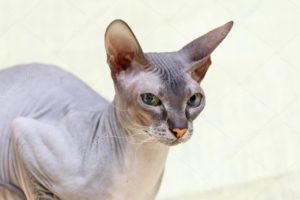
The Donskoy is a mostly hairless cat breed of Russian origin. This breed started in 1987 with the discovery of a hairless cat in the Russian city of Rostov-on-Don by cat breeder Elena Kovaleva. It is not related to the better-known mostly hairless breed of cat, the Sphynx, also known as the Canadian Hairless, whose characteristic hair suppression is caused by a recessive gene, whereas the Don hairlessness is caused by a dominant gene.
The Donskoy was first officially recognized by World Cat Federation (WCF) in 1997, and by The International Cat Association (TICA) in 2005. The standard of points describes the cat as being medium-sized and muscular, with large ears, almond-shaped eyes and distinctive long, webbed toes. They require frequent grooming, in spite of their lack of coat. Over-bathing can cause the skin to become very oily.
The Peterbald breed was originally created by crossing Donskoy with Siamese and Oriental cats to create a hairless cat of Oriental type. Matings between Donskoy and Peterbald are no longer permitted.
Reference: Donskoy
2. Kurilian Bobtail
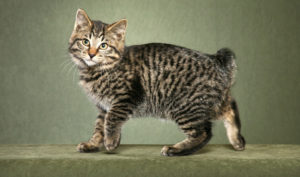
The Kurilian Bobtail is a cat breed (or breed group, depending on registry) originating from the Kuril Islands, as well as Sakhalin Island and the Kamchatka peninsula of Russia. Short- or long-haired, it has a semi-cobby body type and a distinct short, fluffy tail. The back is slightly arched with hind legs longer than the front, similar to those of the Manx. The breed is also called the Kuril Islands Bobtail, Kuril Bobtail (both often misspelt “Kurile”) and Curilsk Bobtail, and may be referred to without “Bobtail”. It is sometimes also spelt Kurilean. The original short-haired variant is a natural breed, known on the islands for over 200 years. As selectively bred pets, they have been popular in Russia and to some extent other parts of Europe, especially for their rodent-hunting abilities, since the middle of the 20th century, but remained rare in North America as of 2011.
Kurilians are recognized as a breed group of a pair related short- and [semi-]long-haired breeds by The International Cat Association (TICA), which considers them “Advanced New Breeds” ineligible for championship status, as of 2011) and by the Fédération Internationale Féline (FIFe). The World Cat Federation (WCF) recognizes them as a single breed. As of 2011, the Cat Fanciers’ Association (CFA) did not recognize the breed at all.
While possibly closely related to the Japanese Bobtail breed – both share the same kind of kinked, short tail, but the Japanese are leaner, more angular and less cobby – the Kurilian originated on the opposite side of Eurasia from the similarly named Karelian Bobtail of western Russia and Finland and is thus unlikely to be a near relative. Genetic studies may eventually demonstrate the breed’s connection to others. Just as the Japanese Bobtail and tailless-to-short-tailed Manx arose independently on islands a world apart, the Kurilian’s bobbed tail may be an isolated spontaneous mutation that became common on the Kuril and Sakhalin islands because of the limited genetic diversity of island biogeography (an example of the founder effect and, at the sub-specific level, of the species-area curve).
3. Peterbald
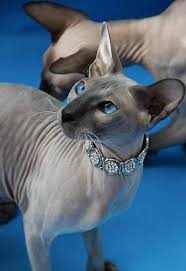
The Peterbald is a cat breed of Russian origin. It was created in St Petersburg in 1994 from experimental breeding by Olga S. Mironova. They resemble Oriental Shorthairs with a hair-losing gene. The breed was accepted for Championship class competition in 2009.
Peterbalds resemble Oriental Shorthairs. They have a hair-losing gene and can be born bald, flocked, velour, brush, or with a straight coat. Those born with hair, excepting the straight-coats, can lose their hair over time. They come in all colours and markings.
Members of the breed have a slim and muscular build. They have a narrow and long head with a straight profile, almond-shaped eyes, wedge-shaped muzzle, and large, set-apart ears. They have a long whip-like tail, webbed feet and oval paws that allow them to grasp objects and open levered doorknobs.
Peterbalds are sweet-tempered, affectionate, peaceful, curious, smart, and energetic. They are medium vocal and tend to follow their owners and always be with them. Peterbalds typically live in harmony with other cats and pets, and also with children.
4. Russian Blue
The Russian Blue is a cat breed that comes in colours varying from light shimmering silver to a darker, slate grey. They develop close bonds with their owners and are sought out as pets due to their personalities, beauty and coat. It is their short, dense coat which has been the hallmark of the Russian breed for more than a century. The dense coat stands out from the body and one can draw patterns in the coat that will stay until one smoothes them out again. They are also considered to be hypoallergenic.
The Russian Blue is a naturally occurring breed that may have originated in the port of Arkhangel’sk in Russia. They are also sometimes called Archangel Blues. It is believed that sailors took Russian Blues from the Archangel Isles to Great Britain and Northern Europe in the 1860s. The first recorded appearance outside of Russia was in 1875 at The Crystal Palace in England as the Archangel Cat. The Russian Blue competed in a class including all other blue cats until 1912 when it was given its own class. The breed was developed mainly in England and Scandinavia until after World War II.
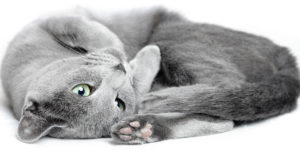
Right after the war, a lack of numbers of Russian Blues led to cross-breeding with the Siamese. Although Russian Blues were in the United States before the war, it was not until the post-war period that American breeders created the modern Russian Blue that is seen in the United States today. American breeders combined the bloodlines of both the Scandinavian and British Russian Blues. The Siamese traits have now largely been bred out. The short hair and slate-grey/blue color is often seen in mixed-breed cats, which can affect breeders and showers due to mislabeling a cat as a Russian Blue.
Russian Blues are plush short-haired, shimmering pale blue-grey cats with emerald green eyes. Guard hairs are distinctly silver-tipped giving the cat a silvery sheen or lustrous appearance. They have been used on a limited basis to create other breeds such as the Havana Brown or alter existing breeds such as the Nebelung. They are being used in Italy as a way to make Oriental Shorthairs healthier and more robust called RUS4OSH in FIFe.
Russian Whites and Russian Blacks were created from crosses with domestic white cats which were allegedly imported from Russia. The first line was developed by Frances McLeod (Arctic) in the United Kingdom during the 1960s and the second line produced by Dick and Mavis Jones (Myemgay) in Australia in the 1970s. By the late 1970s, the Russian White and Russian Black colours were accepted by cat fanciers in Australia as well as in South Africa and now also in the United Kingdom as Russian cats (in different classes). However, the Cat Fanciers’ Association and FIFe do not recognize any variation of the Russian Blue.
5. Siberian cat
The Siberian is a landrace variety of domestic cat, present in Russia for centuries, and more recently developed as a formal breed, with standards promulgated since the late 1980s.
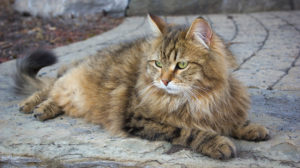
They vary from medium to medium-large in size. A longer name of the formal breed is Siberian Forest Cat, but it is usually referred to as the Siberian or the Siberian cat. Another name for the formal breed is the Moscow Semi-Longhair. The cat is an ancient breed that is now believed to be ancestral to all modern long-haired cats. The cat has similarities with the Norwegian forest cat, to which it is likely closely related. It is a natural breed of Siberia and the national cat of Russia. While it began as a landrace, it is selectively bred and pedigreed today in at least seven major cats fancier and breeder organisations. The colourpoint variant of the breed is called the Neva Masquerade by some registries.
6. Toybob
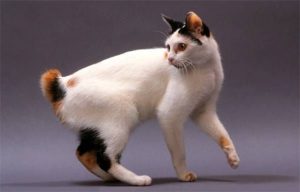
The Toybob is a Russian breed of a small cat weighing between 1 and 6 pounds. They have compact, strong, muscular bodies with short bobbed tails, consisting of several kinked vertebrae. Besides the Toybob’s diminutive size, their most distinctive feature is their large expressive eyes. The cat’s small size and bobbed tails are due to spontaneous mutation in feral cats native to Russia. Toybobs have pleasant temperaments and are affectionate while also obedient to their human companions. Despite their small size, they are active, playful and agile
In 2009 the Toybob was placed by The International Cat Association (TICA) the into the “Experimental” category. In January 2017 the Toybob was given “Registration” status by TICA, allowing for registration facilities but with no guarantee of further advancement.
